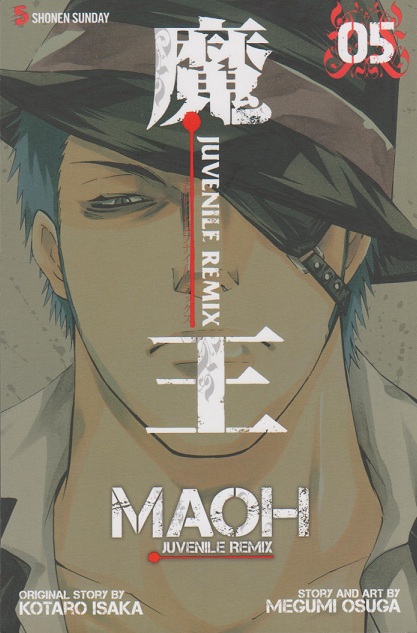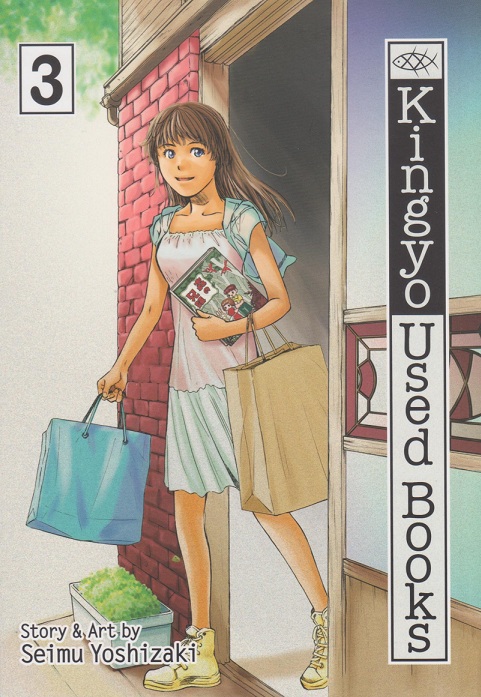 Title: Maoh: Juvenile Remix
Title: Maoh: Juvenile Remix
Author: Megumi Osuga, original story by Kotaro Isaka
Publisher: Viz Media (Shonen Sunday)
Volume: Volume 5 (of 10), $9.99
Vintage: 2008 by Shogakukan in Japan, May 10, 2011 by Viz Media
Genre: Supernatural, drama, action
When we last left off, I was feeling a little guilty about falling for Inukai’s speeches, even while being fully aware of his methods and motivations. Ando was still struggling over his place in Inukai’s destiny, and his inner struggle increased when he made the discovery that using his ventriloquism powers might be wreaking havoc on his internal organs. At a restaurant with his brother, Junya, Ando saw an old man, clinging to life, but a life without purpose, and began to see his own future in the old man. Anderson was paying a visit to a kind elderly couple, while outside the building rioters gathered. Semi was dealing with yet another assassination attempt against the mayor. The three stories converge in volume 4.
As Ando and Junya leave the restaurant, Ando spots a fire burning down the street and rushes to the scene. Anderson is seen coming out of the burning building, carrying an old man on his back. The crowd that has gathered watches the house burn, refusing to help, refusing to call the fire department, and in fact are cheering on the demise of Anderson and the old couple who dared to associate with him. Noting that Anderson is too injured to go back into the house, Ando runs into the flames to save the old woman still inside. Inside the roaring flames, Ando comes to a resolution and decides he’ll keep pushing forward, no matter what it takes, to give his life meaning and make an effort to shape the world however he can. The crowd, furious that Anderson’s son has won again, begin boiling with hatred. Junya tries to talk sense into them, but like before at the school when the students attacked Anderson, the crowd refuses to listen to reason. As the crowd starts to riot, Ando uses the tactics he learned from watching Inukai to attempt to control the crowd. With his ventriloquism, he creates a leader and forces him to draw the crowd’s attention, and then makes the man tear down their ideals and diverts the crowd’s attention long enough to escape. Simultaneously, Semi is in another part of town, fighting for his life. Several professional assassins converge to attack the Mayor, and Semi has his hands full; he tells the Mayor to run without stopping for anything, but of course the man doesn’t follow his advice. Semi expertly dispatches the immediate threat, then heads off to find the Mayor, but quickly finds himself in over his head. A strange man with a patch over his eye awaits Semi in the Mayor’s hotel room. This man calls himself a “suicider.” By drawing his opponent’s gaze into both of his eyes, he is able to amplify their feelings of inner guilt and futility, causing them so much agony they commit suicide. Too late to save the Mayor, Semi, who prides himself on a job well done, is easily manipulated by the mystery man, his doubts about his purpose and his value shooting to the surface of his mind. He failed his job; will Iwanishi take him back? Without his job as Iwanishi’s assassin, will his life have any purpose? A chance encounter with Ando, whose new resolve has made him into a different person than the one Semi was sent after before, knocks a bit of sense into him, but he still has to face his inner demons.
Yeah, sorry, I still totally love this series. Whatever its faults (and it does have them), every volume of this series excites me and makes my heart pound; I can hardly wait to devour the next volume. This time around, things are finally taking a turn. It took five volumes, but Ando finally grew a backbone and decided that since he can do something, he needs to do it, no matter what. During the previous four volumes he was extremely wishy-washy about everything, whining about how helpless he felt, or whining about being thrown into things, or whining about the trouble his power caused him, and finally thinking about quitting altogether when he realized his power might be killing him. For your average Joe, it’s understandable. The world of Maoh: Juvenile Remix is not exactly rainbows and butterflies. For one teenage boy thrown into the lion’s den it can be pretty frightening, no doubt. But for the hero of a story, we want to see him step up to the plate and fight against the villain with all his power, even if it’s not much. Ando has at last reached this stage and is becoming a hero to respect rather than bemoan. His resolve is solidifying, he’s making choices, and he’s putting his very life on the line to stop Inukai. It’s Semi this volume who begins to waver, though it’s not entirely his own doing. The mysterious assassin essentially hypnotizes him, but as he draws upon his victim’s own mental instability, the thoughts driving Semi to kill himself already existed somewhere in his subconscious. Remarkably, it’s his ties to Iwanishi that save him, which brings a new realization to Semi and his existence as well. I like that Semi has a strong presence this volume, and I look forward to his role in the larger picture. I’d love to see him and Ando fighting side by side. Or even against each other, now that they’ve both grown. Inukai is hardly in this volume at all, his presence relegated to a background driving force, but the last few pages set up a big show down that should be exciting. One of the most interesting things to note about this volume, is the aura around Ando as he steps forward to deal with the mob. His whole face changes, and he looks almost demonic. When compared to Inukai, at least physically, it’s hard to tell who is supposed to be the demon, especially since Ando is using tricks he learned watching Inukai. I shall be eagerly awaiting volume 6’s summer release.
 Title: Kingyo Used Books
Title: Kingyo Used Books
Author: Seimu Yoshizaki
Publisher: Viz Media (Sig Ikki)
Volume: Volume 3 (ongoing), $12.99
Vintage: 2006 by Shogakukan in Japan, April 2011 by Viz Media
Genre: Slice-of-life, educational (manga)
I spent more time/space than I was planning for Maoh, so I’ll try to make this one quick. That I’m only mildly interested in it helps. The problem with Kingyo, is that it can often come across as a manga history lesson, rather than a tale of people impacted by the stories in various manga. Sometimes things get mired in its education aspects, and we lose some of the characterization. In volume 3, we start out with a scaredy-cat playboy falling for a beautiful horror manga junkie. To prove he’s serious, he gathers up his courage and reads some Kazuo Umezu manga, and ends up learning a life lesson along the way. Next we have a story with a timely celebration of Sailor Moon (due to its upcoming re-release later this year by Kodansha), in which several females bond together over their shared love for the series in their childhood. It’s overall message is a bit unclear to me, however. It’s about a girl trying to become an artist who is continually shot down. So…the message is that she needs to pretty herself up more to get hired? Or dress up her art? I’m not sure (maybe I’m complicating it). In the next story, a group of unrelated men come together at a local zoo, hoping to see the newest addition, a lone wolf. Every day they sit on a bench facing the cage and wait, and share copies of manga by Sanpei Shirato. Most of them are about a ninja, warrior, or wolf going on a long journey to find something. In a way, it reflects their own situation, as they wait for the wolf to appear, never giving up to see if destiny will allow them to see what they have been waiting so long to see. The next part of the volume brings things back to the “main” characters. The Kingyo gang watches as a relationship unfolds between the sedori Ayu and Tome, as Tome tries to get his feelings across to a stubborn and oblivious Ayu. “The Joy of Living” follows a small group of people trying to individually discover joy in their lives. In one of the previous volumes, a local manga lending store was about to close down, but a couple ended up taking over the store from its elderly owner. “Nekotama-do” part 1 and 2 detail the life of the man who took over the store, chronicling his journey as a wanderer. On his journey, he bumped into a young Tome, and joined a tradition of trading manga when he came across other traveling Japanese speakers. Eventually he came to own Nekotama-do, and discovered a book logging all unreturned manga. In order to return the books to their rightful place, so others can experience them, Nomoto sets off on a new journey to track down an elusive manga with ties to his past.
It’s difficult to tell if Kingyo is meant to be a slice-of-life tale of various characters exploring their lives and their finding new purpose for themselves, or a series whose sole purpose is to teach readers about manga many may be too young to have ever heard of before. In this particular volume we have featured manga from 1968, 1986, 1961, 1992, and 1971. I appreciate the look into manga history, but the ambiguous, somewhat abstract nature of many of these tales is starting to drag down the series for me. While I don’t mind the random stories about random people, I much prefer when the series takes us into the lives of the core characters. Those are my favorite parts, though I understand the series is meant to show that anyone from any walk of life can enjoy manga, connect with particular stories and characters, or connect with other people through manga.
Kris
kristin@comicattack.net
@girlg33k_Kris
Review copies provided by Viz Media.

Pingback: Free Comic Book Day, Kindle drama continues, 25 years of Viz « MangaBlog
Pingback: Bento Bako Weekly: MAOH Juvenile Remix volume 6